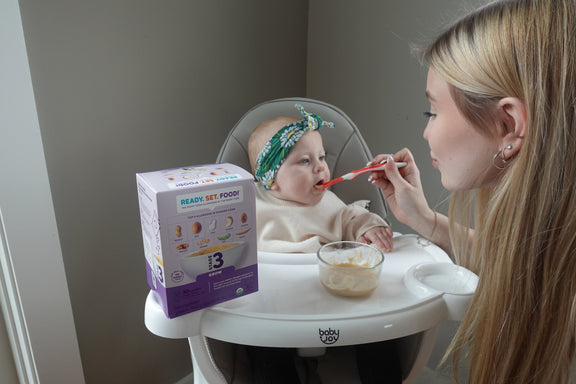You should introduce your baby to milk before their first birthday. Learn how you should introduce cow's milk to your baby.
Babies should be introduced to cow's milk before their first birthday. But many parents have heard that babies shouldn't have cow's milk until they turn one year old. What's the safest approach for baby? What do medical guidelines recommend?
Here's what you'll learn in this article:
- AAP guidelines for introducing cow's milk
- What forms of cow’s milk baby can have as a supplement
- How common is milk allergy and how it can impact your child’s quality of life
- How to follow clinical guidelines for introducing allergy-causing foods
Breastmilk or formula should remain baby’s primary food source
The American Academy of Pediatrics cautions against offering cow's milk as a drink until your baby is 12 months old.
- This is because breastmilk and formula are the best beverage choices for babies under one.
- The AAP guidelines remind you that you should not replace breastmilk or formula with cow's milk before your baby turns one.
Breastfeeding or formula feeding should remain your baby's primary food source through their first year of life, even when you start introducing them to solid foods.
- Even the most nutritious foods and drinks can’t match the optimum levels of vitamins and proteins in breastmilk or formula for babies under one.
- So, there's no substitute for the nutritional value that breastmilk or formula provides to babies at this age.
Once your baby turns one, you can start replacing breastmilk or formula with whole cow's milk to drink.
As long as you continue to rely on breastmilk or formula as your baby’s primary food source, it's perfectly fine to introduce cow's milk in other ways (not as a beverage but as a supplement) before your baby turns one.
Milk allergy trends
- Milk allergy is the most common food allergy in infants and young children.
- It affects 2-3% of children younger than 3 years old.
- Usually, a milk allergy will develop and become evident during a baby's first year of life.
- Most children “outgrow” their milk allergy (or become tolerant to milk later in life).
- However, outgrowing a childhood milk allergy may occur as late as the teenage years.
- In school-age children, milk is the most common cause of reactions at school.
A milk allergy's impact on quality of life
From pizza to cupcakes and more, cow's milk is commonly found in many kid-friendly foods. Milk is one of the hardest allergens to avoid, so a milk allergy causes a significant impact on a child's quality of life.
Social events, like birthday parties, become difficult and isolating because milk is found in cake, ice cream, and many popular snacks (such as Goldfish).
And worst of all, a milk allergy can be life-threatening.
How to introduce milk to your baby?
Based on the results of landmark studies, clinical guidelines recommend introducing your baby to common allergy-causing foods early and often.
Introduce milk early: Introduce cow's milk before your baby turns one. Start as early as 4-6 months (the earlier the better).
Introduce milk often: Sustaining introduction is just as important as starting early. Feed your baby milk products 2-7 times per week for at least several months.
Introducing cow's milk in foods
How to introduce milk before your baby turns one?
Yogurt and ricotta cheese are some safe options for when your baby is ready for solids.
- Be sure that the yogurt or cheese you introduce is made with whole milk.
- Also, be sure it's free of additives, like added sugar or flavors, that babies don't need.
- If the yogurt or cheese is too thick for your baby, thin it to a better consistency using breastmilk or formula.
Plain yogurt: Whole-milk yogurt is a safe early dairy food to introduce to your baby. But be sure it's plain yogurt, not flavored yogurt.
Ricotta cheese: Whole-milk ricotta is another early dairy option, if your baby is eating thicker purees. Ricotta usually contains less sodium than other cheeses.
Ready. Set. Food!: The easy option to introduce milk (plus peanut and egg)
Clinical guidelines recommend introducing milk as early as 4-6 months of age. But what if your baby isn't ready for solid foods at that early age? Or, what if your picky eater won't eat the yogurt or cheese you offer (let alone frequently enough)?
Ready. Set. Food! is a gentle, easy and safe option to introduce milk (as well as egg and peanut) while feeding baby breastmilk or formula. It contains only organic milk, egg and peanut powders, with no additives.
It easily dissolves into a bottle of breastmilk or formula (or a bowl of baby's favorite puree). Thus, you can introduce milk, egg, and peanut to any baby as early as 4 months of age, even if your baby isn't ready for solid foods.
Ready. Set. Food! uses the exact amounts of milk, egg and peanut used in the landmark clinical studies, and is recommended by 1,000+ pediatricians and allergists. Plus, the pre-measured packets eliminate guesswork and save you valuable prep time.

The Window Of Opportunity For Introducing Peanut: New Study Findings From the LEAP and EAT Trials
Results from the landmark LEAP and EAT studies have shown that intr...

Best Finger Foods For Babies (And When To Start Finger Foods)
When to move beyond the spoon and start baby's journey with finger ...

6 Reasons Why You Should Introduce Allergens
Landmark studies and medical guidelines recommend that you introduc...

7 Ways to Feed Your Toddler More Iron
Iron is an essential mineral for your toddler’s brain health and ov...

How To Know If My Toddler Is Getting Enough Protein?
Protein supports your toddler’s growth, helps build strong bones an...

How Much Milk Should Your Toddler Drink?
How much milk should your toddler drink in a day? Find out the reco...
All health-related content on this website is for informational purposes only and does not create a doctor-patient relationship. Always seek the advice of your own pediatrician in connection with any questions regarding your baby’s health.
These statements have not been evaluated by the Food and Drug Administration. Products are not intended to diagnose, treat, cure or prevent any disease. If your infant has severe eczema, check with your infant’s healthcare provider before feeding foods containing ground peanuts.







